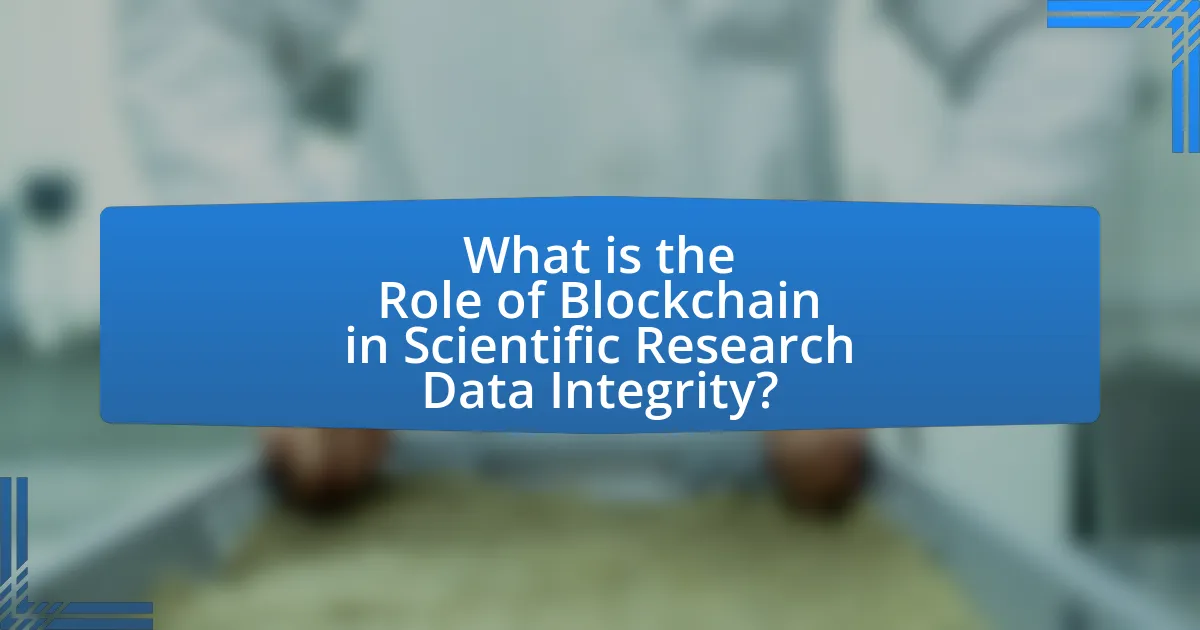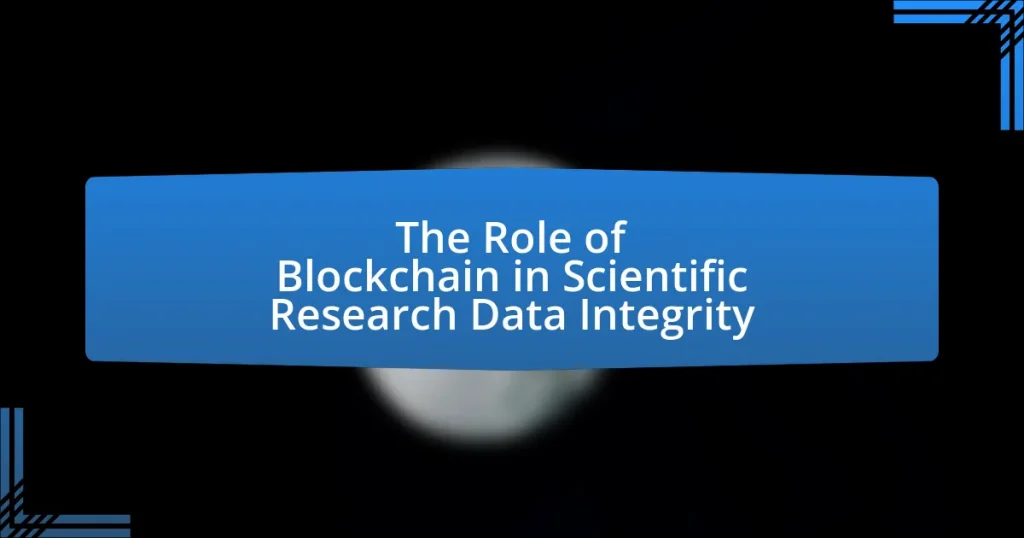Blockchain technology serves a pivotal role in ensuring the integrity of scientific research data by providing a decentralized and immutable ledger for data transactions. This article explores how blockchain enhances data provenance, transparency, and security, thereby fostering trust in research findings. Key features such as immutability and decentralization are discussed, along with the challenges of scalability, interoperability, and regulatory compliance that hinder its adoption in scientific research. Additionally, the article highlights best practices for researchers utilizing blockchain, potential future developments, and available tools and platforms for effective implementation in research frameworks.

What is the Role of Blockchain in Scientific Research Data Integrity?
Blockchain plays a crucial role in ensuring the integrity of scientific research data by providing a decentralized and immutable ledger for recording data transactions. This technology allows researchers to securely store and share data, ensuring that any alterations or tampering can be easily detected due to the transparent nature of blockchain. For instance, a study published in the journal “Nature” highlights how blockchain can enhance data provenance, allowing researchers to trace the origin and modifications of data sets, thereby increasing trust in the research findings. Additionally, the use of smart contracts on blockchain platforms can automate compliance with data sharing agreements, further safeguarding the integrity of scientific data.
How does blockchain technology ensure data integrity in scientific research?
Blockchain technology ensures data integrity in scientific research by providing a decentralized and immutable ledger that records all transactions and data entries. Each piece of data is stored in a block, which is linked to the previous block, creating a chain that is resistant to tampering. This structure ensures that once data is recorded, it cannot be altered without consensus from the network, thereby maintaining the authenticity and reliability of the research data. Additionally, the use of cryptographic hashing secures the data, making it verifiable and traceable, which is crucial for validating scientific findings. Studies have shown that implementing blockchain in research can significantly reduce data manipulation and enhance transparency, as evidenced by projects like the “Blockchain for Open Science” initiative, which aims to improve data sharing and integrity in scientific communities.
What are the key features of blockchain that contribute to data integrity?
The key features of blockchain that contribute to data integrity include immutability, transparency, and decentralization. Immutability ensures that once data is recorded on the blockchain, it cannot be altered or deleted, which protects against tampering and fraud. Transparency allows all participants in the network to view the same data, fostering trust and accountability. Decentralization distributes control across multiple nodes, reducing the risk of a single point of failure or manipulation. These features collectively enhance the reliability of data in scientific research, as evidenced by studies showing that blockchain can significantly reduce data discrepancies and improve audit trails in research environments.
How does decentralization in blockchain enhance data security?
Decentralization in blockchain enhances data security by distributing data across a network of nodes, making it less vulnerable to attacks or failures. In a centralized system, a single point of failure can compromise the entire database, whereas in a decentralized system, data is replicated across multiple locations, ensuring that even if one node is attacked or goes offline, the data remains intact and accessible from other nodes. This redundancy significantly reduces the risk of data tampering or loss. Furthermore, blockchain employs cryptographic techniques to secure data, ensuring that any alterations are easily detectable, thus maintaining the integrity of the data.
Why is data integrity crucial in scientific research?
Data integrity is crucial in scientific research because it ensures the accuracy and reliability of data, which is fundamental for drawing valid conclusions. When data is accurate and trustworthy, researchers can replicate studies, build upon findings, and contribute to the body of scientific knowledge. For instance, a study published in the journal “Nature” highlighted that data integrity issues can lead to flawed research outcomes, undermining public trust in scientific findings. Therefore, maintaining data integrity is essential for the credibility of scientific research and the advancement of knowledge.
What are the consequences of compromised data integrity in research?
Compromised data integrity in research leads to invalid results, which can misinform scientific conclusions and policy decisions. When data is altered or falsified, the reliability of research findings diminishes, potentially resulting in wasted resources and efforts on flawed studies. For instance, a study published in the journal “Nature” highlighted that data manipulation can lead to significant public health risks, as incorrect findings may influence medical guidelines and treatment protocols. Furthermore, compromised integrity can damage the credibility of researchers and institutions, leading to a loss of trust among stakeholders, including funding bodies and the public.
How does data integrity impact the reproducibility of scientific findings?
Data integrity directly impacts the reproducibility of scientific findings by ensuring that data remains accurate, consistent, and trustworthy throughout the research process. When data integrity is compromised, it can lead to erroneous results, making it difficult or impossible for other researchers to replicate the findings. For instance, a study published in the journal “Nature” highlighted that reproducibility issues in scientific research often stem from data manipulation or loss of data integrity, which undermines the reliability of conclusions drawn from the research. Thus, maintaining data integrity is crucial for validating scientific claims and fostering trust in the scientific community.
What challenges does blockchain face in the context of scientific research?
Blockchain faces several challenges in the context of scientific research, primarily including scalability, interoperability, and regulatory compliance. Scalability issues arise because blockchain networks can struggle to handle the high volume of transactions required for large-scale scientific data, leading to delays and inefficiencies. Interoperability challenges occur as different blockchain platforms may not easily communicate with one another, hindering data sharing and collaboration across research institutions. Additionally, regulatory compliance poses a significant hurdle, as the decentralized nature of blockchain can conflict with existing data protection laws, such as GDPR, which require specific data handling and privacy measures. These challenges must be addressed to fully leverage blockchain’s potential in enhancing data integrity in scientific research.
What are the technical limitations of implementing blockchain in research?
The technical limitations of implementing blockchain in research include scalability issues, high energy consumption, and integration challenges with existing systems. Scalability is a significant concern as many blockchain networks struggle to handle large volumes of transactions efficiently; for instance, Bitcoin processes approximately seven transactions per second, which is inadequate for extensive research data. High energy consumption is another limitation, as the proof-of-work consensus mechanism used by many blockchains requires substantial computational power, leading to environmental concerns. Additionally, integrating blockchain with existing research infrastructures can be complex, as it often requires significant changes to current data management practices and interoperability with various data formats and systems. These limitations hinder the widespread adoption of blockchain technology in the research sector.
How do regulatory and compliance issues affect blockchain adoption?
Regulatory and compliance issues significantly hinder blockchain adoption by creating uncertainty and increasing operational costs for organizations. These challenges arise from the lack of clear legal frameworks governing blockchain technology, which can lead to hesitance among businesses to invest in or implement blockchain solutions. For instance, the European Union’s General Data Protection Regulation (GDPR) poses specific challenges for blockchain, as it mandates the right to be forgotten, conflicting with the immutable nature of blockchain records. This regulatory ambiguity can deter organizations from leveraging blockchain for scientific research data integrity, as they may fear non-compliance penalties or legal repercussions.
How can blockchain be integrated into existing research frameworks?
Blockchain can be integrated into existing research frameworks by utilizing its decentralized ledger technology to enhance data integrity and transparency. This integration allows researchers to securely record and verify data transactions, ensuring that all research findings are immutable and traceable. For instance, by employing smart contracts, researchers can automate data sharing and access permissions, which streamlines collaboration while maintaining data security. Additionally, studies have shown that blockchain can reduce fraud and increase trust among stakeholders in research, as evidenced by the implementation of blockchain in clinical trials, which has improved data accuracy and participant consent management.
What are the potential future developments of blockchain in scientific research?
Potential future developments of blockchain in scientific research include enhanced data integrity, improved collaboration, and streamlined funding processes. Blockchain technology can provide immutable records of research data, ensuring that findings are verifiable and reducing instances of data manipulation. For instance, projects like the Open Science Framework utilize blockchain to create transparent and traceable research workflows, which can foster trust among researchers and institutions. Additionally, smart contracts on blockchain platforms can automate funding disbursements based on predefined milestones, thus increasing efficiency in grant management. These advancements are supported by ongoing initiatives and pilot programs in various scientific fields, demonstrating the practical application of blockchain for improving research integrity and collaboration.
What best practices should researchers follow when using blockchain for data integrity?
Researchers should ensure data integrity by implementing best practices such as using immutable ledgers, ensuring transparency through public access, and employing cryptographic techniques for data security. Immutable ledgers prevent unauthorized alterations, as once data is recorded on the blockchain, it cannot be changed without consensus from the network. Transparency allows stakeholders to verify data authenticity, fostering trust in research findings. Additionally, cryptographic techniques, such as hashing and digital signatures, protect data from tampering and ensure that only authorized users can access or modify the information. These practices are supported by the inherent characteristics of blockchain technology, which has been shown to enhance data integrity in various applications, including scientific research.
How can researchers ensure the effective use of blockchain technology?
Researchers can ensure the effective use of blockchain technology by implementing standardized protocols for data entry and validation. These protocols facilitate accurate and consistent data recording, which is essential for maintaining data integrity in scientific research. For instance, the use of smart contracts can automate compliance checks and ensure that data is only entered by authorized personnel, thereby reducing the risk of human error or fraud. Additionally, studies have shown that blockchain’s decentralized nature enhances transparency and traceability, which are critical for verifying the authenticity of research data. According to a report by the World Economic Forum, blockchain can improve data integrity by providing an immutable record of all transactions, making it easier to audit and validate research findings.
What tools and platforms are available for implementing blockchain in research?
Several tools and platforms are available for implementing blockchain in research, including Ethereum, Hyperledger Fabric, and IBM Blockchain. Ethereum provides a decentralized platform for creating smart contracts, which can enhance data integrity in research by ensuring that data is immutable and verifiable. Hyperledger Fabric is a permissioned blockchain framework that allows organizations to collaborate on research while maintaining control over their data. IBM Blockchain offers enterprise solutions that facilitate secure data sharing and collaboration among researchers. These platforms support various use cases in scientific research, such as data provenance, secure sharing of research findings, and ensuring compliance with regulatory standards.


